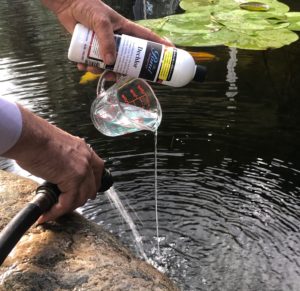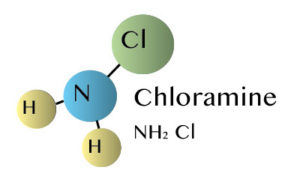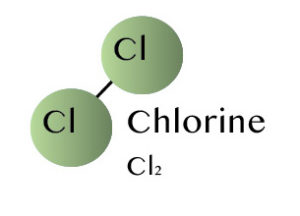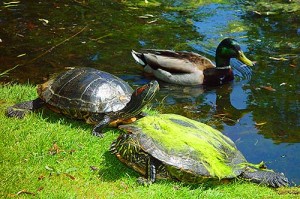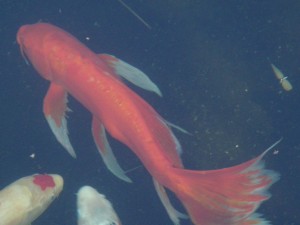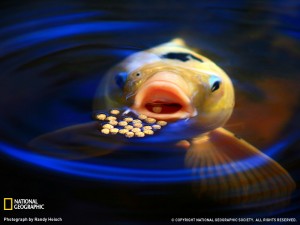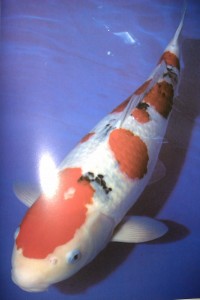When adding water to a pond, the tap water that comes from your hose contains chlorine and chloramines, which are harmful to your fish. Chlorine is toxic to most aquatic life, and it can cause stress and bad burns to the fish once it reaches the gills and its internals. Chlorine will cause burns upon contact, damaging the gills, scales, and breathing tissue of goldfish and koi. Also, interestingly, it readily enters the blood stream after it passes through the gills, causing internal burning, stress, and significant pain to the fish. The solution to this is to add the Pond Company’s Dechlor. Dechlor is short for a water dechlorinator, which is a water conditioner that neutralizes the chlorine, chloramine, and other heavy harmful substances. Dechlor should always be used whenever we add water to a pond, and whenever we do a water change to neutralize the chemicals before they affect the fish and the ecosystem. A bottle of the Pond Company’s Dechlor can be purchased for only $17.95 (see store), please give us a call if you are interested in purchasing (626)-284-5937 or drop us an email at: info@thepondcompany.com.
Chlorine & Chloramine Kill!
What is Chloramine?
Chloramine is used to bond chlorine to water. It is added by our metropolitan water districts in combination with chlorine to sanitize and disinfect the tap water that comes to your home and business. Sanitize kills everything living without discretion, including your fish!
Chloramines first started to be used in the 1980s. Prior to that time, Chlorine would rapidly dissipate from the water, but Chloramines make Chlorine stay in the water for a longer period of time.
Chloramines are a group of chemical compounds that contain Chlorine and Ammonia. Chloramine locks Chlorine and Ammonia to the water molecule, so it stays active in the water for a longer period of time.
Although we are told that the use of Chloramine in our water makes it safe for humans to drink (debatable given all the bottled water we buy), it is definitely harmful to fish. Chloramines are toxic to fish, because the fish will take up chloramines directly through their burned gills into their blood stream – not good! We recommend that the water used for your pond always be free of Chloramines. (See blog on how to treat for Chlorine & Chloramine)
The Pond Company’s Latest Installation
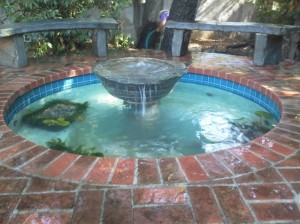 The Pond Company’s latest and greatest installation is a beautiful converted spa that has been transformed into a fantastic water feature. The centerpiece is a custom basin, made from Bouquet Canyon/High desert Stone, that flows into the pond surrounded with accent benches. The pond itself will be stocked with fancy goldfish and shubunkins as well as a gorgeous array of water-plants and water-lilies.
The Pond Company’s latest and greatest installation is a beautiful converted spa that has been transformed into a fantastic water feature. The centerpiece is a custom basin, made from Bouquet Canyon/High desert Stone, that flows into the pond surrounded with accent benches. The pond itself will be stocked with fancy goldfish and shubunkins as well as a gorgeous array of water-plants and water-lilies.
Waging a losing war against mosquitoes
(CBS News)The Fourth of July is a day for parades and fireworks and picnics and outdoor activities of every kind. Just don’t forget to bring the mosquito repellant. Mosquitoes are the unwelcome guests at many an outdoor party, and not just because they’re annoying. Tracy Smith reports our Cover Story:
They’re as much a part of summer as watermelon and sunburns. Mosquitoes are found in every state, on every continent (except Antarctica). And for them, 2012 has already been a very good year.
“We had no winter in the Northeast this year, and so there’s a lot of predictions from mosquito control experts that we’re going to have a really huge season of high populations of mosquitoes, and so with that, more disease transmission,” said Leslie Vosshall, who runs Rockefeller University’s Laboratory of Neurogenetics and Behavior in New York City. Along with her staff, she’s trying to find out exactly how mosquitoes hunt humans.
“I love mosquitoes,” said Vosshall. “I have completely fallen in love with mosquitoes. They’re beautiful creatures. They have beautiful behaviors. But they’re dangerous.”
“Most people, if you said, ‘Mosquitoes are beautiful,’ would tell you you’re crazy,” said Smith.
“Exactly. I get that a lot,” she laughed.
She’s really not crazy – but her dedication to her work seems jaw-droppingly insane, especially around feeding time, when Vosshall sticks her arm into a mosquito cage: “These are hungry girls and some boys,” she said. Vosshall needs healthy mosquitoes for her work, and this, she says, helps keep them that way.
Only female mosquitoes bite, and only then because they need the blood to make eggs.
There are several ways to feed lab mosquitoes: this way, Vosshall says, is the best, despite what it does to her arm. “I feel good,” she said. “I’ve done my job.”
The telltale welts are the body’s reaction to the saliva mosquitoes inject to make your blood flow. Over time, her body has become accustomed to this routine. Still, there’s nothing routine about her work.
“What’s interesting is that the really dangerous disease-causing mosquitoes have acquired a taste for humans,” she said. “So Anopheles gambiae, which spread malaria, the principle vector of malaria, prefers humans over all other animals.”
Besides anopheles, some other mosquitoes high on the human misery list are the dengue fever carrier Aedes aegypti, that, in this country, is found mostly in the Southeast; and Culex pipiens, a carrier of West Nile virus, that can be found coast to coast. They, too, have a taste for us . . . and some of us are mosquito magnets.
Researcher Lindsay Bellani turns mosquitoes loose on a volunteer’s bare arms. “We measure how many are trying to bite the person after five minutes,” Bellani explained.
Scientists here are looking at what drives them wild – blood components, skin bacteria – so they can figure out a way to stymie the mosquitoes’ incredible ability to find us.
“They’re not working off of very much, but they do it so, so well,” said Bellani, “and in some way I’ve developed a weird kind of respect for mosquitoes.”
The CDC has respect for mosquitoes, too. The agency was created in 1946 to fight malaria, and while malaria’s been all but wiped out in the U.S., there were more than 700 reported cases of the deadly West Nile virus here last year alone.
So in places like Fairfax County, Va., they keep a close eye on mosquito traps.
“I have a lot more respect for West Nile virus today than I ever had before,” said Jorge Arias, who heads the program. He said he would’ve shown us the traps personally but it’s hard for him to walk; he was infected with West Nile himself two years ago, and is still partially paralyzed as a result.
But he’d be the first to tell you that there are worse things than West Nile out there.
Kimberly King never gave mosquitoes a second thought until her five-year-old daughter Adreana was bitten by a mosquito carrying the rare Eastern Equine Encephalitis, or EEE, somewhere near their home south of Boston.
“We could have been swimming, we could have been hiking in the woods, we could have been fishing,” said King. “We could have been sitting on the back porch. We could have been driving in the car.”
The girl went to her mother saying she didn’t feel well: “She seemed to have flu-like symptoms,” said King. “And then within 24 hours of her first symptom, she was seizing.”
After a week in intensive care it was clear that the little girl would not recover.
“We had to make the decision to take her off the life support,” said King. “And we took her off the life support, she was in my arms. I was holding her as she died.
“They took her off all of her machines and her hoses in my arms, and they allowed me to help wash her up before they sent her down to the morgue.”
Kimberly King buried her daughter on the day she would’ve started kindergarten. She’s become a full-time advocate for mosquito repellant and control, as a commissioner at the Plymouth County Mosquito Control Project.
But she says she doesn’t feel like the unlucky one in a million: “There were others before me, and unfortunately, there’ll be others after me,” she told Smith.
Still, death by mosquito is extremely rare in the U.S. In 2010 just over 100 people here died of mosquito-borne diseases. Those numbers would be higher, experts say, if not for aggressive mosquito control.
Shelley Redovan, executive director of Lee County Mosquito Control District, said her arsenal includes around a dozen aircraft that cover the 1,200-square-mile county, spraying for mosquito larvae that breed wherever there’s standing water – which, down here, can be pretty much anywhere.
And in Florida, where the bugs naturally thrive, it’s about more than public health.
“It used to be that tourists would come to Florida two months out of the year because that was the only time they didn’t have that many mosquitoes,” said Redovan. “But we have since been able to control them so we can have a tourist season 12 months out of the year.”
“Some people might ask, if you can’t reach it by ground, is it really a concern?” asked Smith. “Aren’t those mosquitoes out there in the wild somewhere?”
“Ideally it would be nice if mosquitoes stayed where they hatch off, but coastal mosquitoes in particular are very strong fliers,” said Redovan. “When they hatch there, they can easily fly 25 miles a day.”
So the agency covers a wide area. To those who worry about environmental impact, Redovan said the spray is formulated to be toxic only to mosquitoes, and its effect: only temporary.
After every high tide and rainfall, and after every spray run, an agent checks ponds and puddles to see how many mosquito larvae have started life anew.
But with swarms able to regenerate in a matter of weeks, and with an average of two new mosquito transmitted diseases found here every year, the threat of the next epidemic is never far over the horizon.
When asked if mosquitoes could ever be wiped out, Vosshall said, “We haven’t been successful so far, right? In the 1950s, we came up with insecticides that knocked the populations down a lot. But then the problem is, you’ll always have a few mosquitoes that developed resistance.”
“It’s an arms race,” said Vosshall. “We have to constantly come up with new insecticides to try to knock down the populations.”
“Who’s ahead? Asked Smith.
“Mosquitoes are ahead, unfortunately,” Vosshall replied. “Mosquitoes are winning.”
Learn More at http://www.cbsnews.com/8301-3445_162-57464498/waging-a-losing-war-against-mosquitoes/?pageNum=3&tag=contentMain;contentBody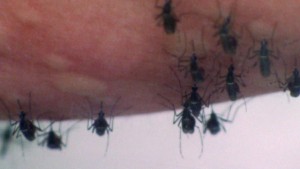
The Life Cycle of a Mosquito
 There are 2500 different type of mosquito species throughout the world of which 150 of those species are in the Untied States. 52 species occur here in California. All mosquitos must have water to complete their life cycle. The water can range from snow melt to sewage effluent and it can be in any container imaginable. Mosquito larvae are identified by the type of water they lay their eggs in. The adults also show a preference for the type of sources in which to lay their eggs. They lay their eggs in places like tree holes that hold water, tide water pools, sewage effluent ponds, irrigated pastures, rain water collect, ect.
There are 2500 different type of mosquito species throughout the world of which 150 of those species are in the Untied States. 52 species occur here in California. All mosquitos must have water to complete their life cycle. The water can range from snow melt to sewage effluent and it can be in any container imaginable. Mosquito larvae are identified by the type of water they lay their eggs in. The adults also show a preference for the type of sources in which to lay their eggs. They lay their eggs in places like tree holes that hold water, tide water pools, sewage effluent ponds, irrigated pastures, rain water collect, ect.
Mosquitos have unique feeding habits in which the female mosquito will feed on man and other animals. The male mosquito feeds only on plant juices. Some female mosquitos prefer to feed on one type of animal or they can feed on a variety. Female mosquito feed on man, domestic animals, such as cattle, horses, goats, etc; all types of birds; all types of wild animals and they also feed on snakes, lizards and frogs.
Female mosquitos need to get a sufficient blood supply to develop eggs. If they don’t get this meal, then they will die without laying eggs. There are some species that can lay viable eggs without getting a blood meal.
The length of life of the adult mosquito depends on different factors: temperature, humidity, sex of the mosquito and time of year. The male mosquito lives very short time, which is about a week; and females live about a month depending on the above factors.
There are four distinct stages of life that a mosquito goes through: Egg, Larva, Pupa, and Adult.
Eggs: The eggs are laid one at a time and float on the surface of the water. Culex and Culiseta species, the eggs are stuck together in rafts of a hundred or more. Anopheles and Aedes species do not make egg rafts but lay their eggs separately. Culex, Culiseta, and Anopheles lay their eggs on water, but Aedes lays their eggs on damp soil that will be flood with water. Most eggs will hatch into larvae within 48 hours.
Larva: Larva live in the water and swim to the surface to breathe. After each molting, they shed their skin four times growing larger. Most larvae have siphon tubes for breathing and hang from the surface of the water. Larva feed on micro-organisms and organic matter in the water. The larva changes into a pupa on the fourth molt.
Pupa: The pupal stage is a resting, non feeding time. This is when the mosquito turns into an adult. It will take about two days before the adult is fully developed. The pupal skin will split and the mosquito will emerge when development is complete.
Adult: The adult mosquito will rest on the surface of the water for a short time to let itself dry and all its parts harden. This will give the wings a chance to dry so it can fly off.
Temperature play a big part during the life cycle of a mosquito. For instance, the Culex tarsalis might go through its life cycle in 14 days at 70 F and take only 10 days at 80 F.
The Answer: Mosquito Fish
Turtles and Ducks,Yuck Yuck Yuck!
Turtles and Ducks may be cute and exciting to watch, but their feces is very rich and tend to pollute water very quickly. It is also very hard to filter their feces because being so rich like “stinky gooey chocolate” that a biological filtration is needed. Sometimes you can never get enough to handle the load that is producing. Another problem is that they both eat fish, small fish usually.
I had a client that was complaining of a fin disease inflicting his koi. On examination on the fish, I pointed out to him the “diseased” fins had chunks missing that was the exact shape of the turtles beak. The turtle was biting the fins of the fish!
Ducks can easily carry disease in feces. As they feed on fish from another pond and fly into your pond and poop, this will bring disease to your water garden and effect your fish. Both Turtles and Ducks forge and dig in soil and aquatic plants for grub, which makes a mess. Another problem are ducklings, yes they are cute as a button and who wouldn’t want baby ducks swimming around in their pond, but duckling who nest in a pond are a problem. I had a friend who once allowed ducks to nest and they had a joy watching them. Then.. they leave the nest and migrate back. Which means they will nest their ducklings in the pond and the cycle will go on and on for years and years till he had so many ducks on his property, him and his wife were trying to get them out of their yard.
Our advice, don’t put ducks and turtles in your pond!
P.S. We do have some clients that have turtles and ducks, we just clean the ponds more often then usual.
Stressed Out Koi
Koi keeping is an important part of Pond Care and stress is an impending part of it. We all go through stress in our lives to being uncomfortable and new to something. Fish living out in nature would simply swim away from stressful conditions, but when they are confined in a pond or tank there is no way for them to swim away. Ammonia levels can get too high and this can cause them a lot of stress. Fish have a hard time dealing with change in their environment, including temperature. That is why when you move any fish from one water source to another they need to be acclimated before being put in. This goes for pH, hardness and alkalinity of its new home.
Feeding Fish
Feed fish what they want observe them, listen to the fish. They will let you know whether they are hungry or not. 15-20 minutes after placing the food in the water for the fish to eat, there should be no floating food left. If there is food, you have fed them too much.
Fish are cold-blooded animals. Their metabolism is based on the temperature of the water they live in. Warmer water creates faster metabolisms. Fish will eat more and need more food to survive. Colder water creates slower metabolisms in fish. They will eat less food. In fact, at 50 F / 30 C you stop feeding goldfish and koi. Below 50 F / 30 C if they do swallow food, the food will spoil before it passes out of their long intestinal track. This leads to all types of problems sickness, diseases, digestive problems, etc. Note that normally they will not eat when it is this cold and the uneaten food will only spoil, clog and over load your filter system, disturb the pond balance and possibly create an unhealthy and detrimental situation. Thus note at 50 F / 30 C and below DO NOT FEED YOUR FISH!
Start feeding once a day as the temperature warms in the spring. When it warms, koi can be fed multiple times a day. As the weather cools in the fall, gradually slow down on the quantity till you stop at 50 F.
Koi/Carp are bottom-feeding fish in nature. The barbs on either side of their mouths are used to tactilely feel along the bottom of a lake for food. They are omnivores. An omnivore is a kind of animal that eats either other animals or plants. Naturally, their diet would consist of worms, crustaceans, plant life, etc. We have trained koi to come to the surface with floating food for our own enjoyment.
Koi food companies are doing their best to create dietary mixtures in their foods and for the most part they are doing a good job. And yet there is still a belief that the dietary needs of koi are still most optimally met by augmenting a variety of foods some proteins, plants, starch, etc. This can include not just pelleted/processed foods, but also fruit sliced oranges, grapefruit, watermelon, grains -rice, wheat, bread.
Japanese Koi
The Japanese Koi are world wide known as beautiful fish composed of brilliant colors and markings. People who own these fish can tell you how wonderful it is to be part of their lives. There is a mysterious past that surround this awesome fish. A lot of people still wonder where they have originated from.
Koi is a Japanese name meaning Carp, but the original word comes from the latin word Cyprinus Carpio meaning Carp. Many people believe the Koi came from Japan, but it is understood that Japanese Koi have come from the waters of the Caspian Sea and around China. There are records of carp fossils found in China dating back 20 million years and showing early accounts of the first color mutations being bred in China.
It is unclear as to where Koi are from, but there are a lot of stories that Koi have been brought to Japan by the Chinese invasion. Another says that Japans emperor had kept Koi in 200 AD. The history of Japanese Koi is pretty vague. As to what really happed between the 2nd and the 17th century is an ongoing exploration still today.
Koi Colors and Patterns
Taisho Sanke
Sanke, are another popular koi, along with Kohaku and Showa. Sanke means tri-color, the three colors being red, white and black. In Japanese characters the word Sanke is also read as Sanshoku, the term used in early works on koi.” (Kin Matsuba pg.136) Hobbysts in many countries love the Sanke because of their extensive variety of designs.
Taisho is in reference to the period when the Sanke was first recorded in Japanese history. This was between 1912 and 1926. “Over the past 60 years the markings of the Sanke have changed quite dramatically. The first Sanke were very striped in appearance , but todays show winning Sanke is a beautifully balanced koi whose sumi, although deeper in shade, is more delicate in appearance than that of its ancestors.” (Kin Matsuba pg.136)
Matsuba, Kin-“The Tetra Encyclopedia of Koi” By, Kin Matsuba
